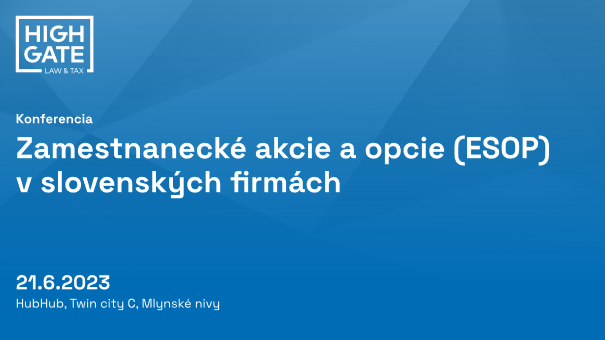
We like to do things differently, we even enjoy doing things differently. And obviously this approach proved to be successful when we organized a conference on ESOP – employee stock and stock options in Slovak companies. In a packed half-day programme, we wasted no time with theory, but brought practical insights and actionable information for entrepreneurs based on our years of practical experience and linking the key areas of law, tax and accounting.
In three entries, we focused on best practices in Slovak companies, starting with the process of setting up a functioning ESOP program with creative suggestions for types of employee compensation and the associated minimization of tax and levy implications. We also covered approaches to properly valuing a company when issuing an ESOP, seamlessly moving on to the topic of current trends associated with issuing employee stock to the setup (different approaches) and managerial handling of Good Leaver/Bad Leaver situations.

For those who missed the conference, this article provides a small taste of what we covered at the ESOP conference. If you are interested in the topic in more depth, there is a video recording of the conference, which you can find here.
In particular, we present how important it is to set up the whole structure correctly at the very beginning of the ESOP program, taking into account the potential growth of the company, the entry of an investor or even legislative innovations, which can make the existing ESOP program more effective if set up correctly.
ESOPs are a complex topic that is not enough to look at only through a legal and tax lens. In the first step, of course, it is important to work with the ESOPist’s vision and knowledge of the company that intends to set up an ESOP program. Subsequently, other issues such as:

Our task is therefore for the client “under one roof” to take into account all relevant facts and provide the most ideal economic, legal and tax-tax setup of the option program, including service such as:
The ESOP concept brings with it many concepts, and it is necessary for the client to think about them before we start setting up a specific strategy for him or her. It is mainly a decision on what conditions will be set in the ESOP. It mainly concerns:
An ESOP acts as a powerful motivational and rewarding tool to attract and retain employees or reduce turnover in the company. At the same time, it motivates employees to perform better at work, which is also linked to the growth of the company. However, this is only true if the ESOP is set up correctly and efficiently. In practice, we also encounter the opposite situations where we have to deal with “dead equity” in the company, namely a “non-working ESOPist” who has already been assigned a real, tangible stake in the company.

A poorly set up ESOP can also have a demotivating effect on employees, which is the opposite of the purpose of such a program. For example, after the vesting period, an employee may lose the motivation to perform his or her job as effectively as during this period of share maturation. Therefore, it is necessary to set up the ESOP in such a way that the employees have an incentive to work or stay in the company even after the “vesting period” has expired.
One of the reasons for employee demotivation can be the poor setting of Good Leaver / Bad Leaver conditions. In practice, we often deal with a variety of “bad leaver” situations, most of which require a sophisticated and complex approach. Therefore, it is most ideal for companies to set these conditions upfront as a precaution in clear and practically enforceable language and manner. Of course, setting a fair playing field also applies to the “good leaver” situation.
When setting up an ESOP, it is more than desirable to comprehensively anticipate all potentially problematic situations and one of them is the possible dispute about the value of the share and therefore how to determine the “fair market value” (FMV), what methods to use to value a company or, for example, a Start-up with a unique product and difficult predictability of its development in the next stages, and who to contact to develop the FMV for your business model.
The company has a choice as to what kind of “shares” it offers to its employees. In the conditions of the Slovak Republic it is in particular:
Already at this step, when choosing the type of shares, it is necessary to consider the economic and tax-tax implications. The choice of the type of shares is undoubtedly linked to the choice of the legal form of the ESOPist, where our legislation gives us four options to choose from, the choice of which depends on the specific realities of the intended structure, namely:
Each legal form has its specifics, or its advantages and disadvantages. Already at the conference we outlined the essential advantages of the less used legal form of the cooperative, as well as the use-cases of the correct set-up in practice. It is important to note, however, that there is no such thing as the “most correct” choice of legal form, but in any case it is very important to make a comprehensive assessment of which legal form is the most “ideal” choice for a given case.
In practice, it is relatively common to encounter the creation of an ESOP structure abroad. There are a number of legitimate reasons for this:

ESOPs entail certain “milestones” which also need to clearly set the conditions under which they occur. We mean the following:
In the case of employee shares, a fundamental problem arises in practice from our point of view, namely the question of the timing of taxation. The Income Tax Act provides for the accrual of non-cash income – taxation – at the time of acquisition of employee shares by the employee. In the case of options, there are views that the moment of taxation occurs even a little earlier. However, such a procedure contradicts the principle of taxation, where taxation on the acquisition of employee shares is to occur at a point in time when neither the employer nor the employee has cash income on which tax and levies can be paid.
For our clients, we therefore try to find legal ways to set up the ESOP structure so as to divert the moment of taxation to the moment of actually received cash income, or to reduce the rate of taxes and levies, or to minimize the risks of a possible tax audit.
As we said in several case studies at the conference, each client needs to be considered on an ad hoc basis, and there is no sort of one-size-fits-all template that just rolls over to the firm without knowing the client’s requirements. In any case, we will be happy to create and run a tailor-made solution for your business with an optimal mix of legal and tax-efficient structure.

The recently adopted amendment to the Income Tax Act has at least triggered a positive response within the startup environment. Under the rules in effect prior to this amendment, a critical portion of shares awarded to an employee or contractor had to be taxed as non-cash income. In practice, therefore, various arguments and structures have been devised to eliminate this risk. The amendment was intended to shift this taxation to the moment of realisation of income in the form of an “EXIT” share.
However, despite the certainly noble motive, the amendment does not fully address this need and it appears that it may be unused in practice without fiscal risks. It is therefore possible that the new legislation will still be subject to some changes.
As the ecosystem around crypto assets develops, we are increasingly seeing the distribution of various crypto assets to team members. This was also addressed at the conference.

If you are interested in this topic and would like to know more about it, a video recording of the conference is available right here below the article.

If you are interested in this topic, please do not hesitate to contact us.
Law & Tax
Tomas Demo
tomas.demo@highgate.sk
Accounting
Peter Šopinec
peter.sopinec@highgate.sk
Crypto
Peter Varga
peter.varga@highgate.sk